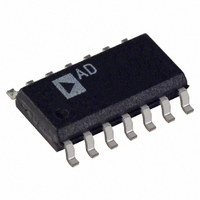AD824AR-14 Analog Devices Inc, AD824AR-14 Datasheet - Page 13

AD824AR-14
Manufacturer Part Number
AD824AR-14
Description
IC OPAMP JFET R-R 2MHZ LP 14SOIC
Manufacturer
Analog Devices Inc
Datasheet
1.AD824ARZ-14-REEL.pdf
(16 pages)
Specifications of AD824AR-14
Slew Rate
2 V/µs
Rohs Status
RoHS non-compliant
Amplifier Type
J-FET
Number Of Circuits
4
Output Type
Rail-to-Rail
Gain Bandwidth Product
2MHz
-3db Bandwidth
2MHz
Current - Input Bias
4pA
Voltage - Input Offset
500µV
Current - Supply
560µA
Current - Output / Channel
12mA
Voltage - Supply, Single/dual (±)
3 V ~ 30 V, ±1.5 V ~ 15 V
Operating Temperature
-40°C ~ 85°C
Mounting Type
Surface Mount
Package / Case
14-SOIC (3.9mm Width), 14-SOL
Op Amp Type
Low Power
No. Of Amplifiers
4
Bandwidth
2MHz
Supply Voltage Range
3V To 30V
Amplifier Case Style
SOIC
No. Of Pins
14
Operating Temperature Range
-40°C To +85°C
Lead Free Status / RoHS Status
Contains lead / RoHS non-compliant
Available stocks
Company
Part Number
Manufacturer
Quantity
Price
Part Number:
AD824AR-14
Manufacturer:
ADI/亚德诺
Quantity:
20 000
Company:
Part Number:
AD824AR-14-REEL
Manufacturer:
AD
Quantity:
1 240
3 Volt, Single Supply Stereo Headphone Driver
The AD824 exhibits good current drive and THD+N perfor-
mance, even at 3 V single supplies. At 1 kHz, total harmonic
distortion plus noise (THD+N) equals –62 dB (0.079%) for a
300 mV p-p output signal. This is comparable to other single
supply op amps that consume more power and cannot run on 3 V
power supplies.
In Figure 6, each channel’s input signal is coupled via a 1 mF
Mylar capacitor. Resistor dividers set the dc voltage at the
noninverting inputs so that the output voltage is midway between
the power supplies (1.5 V). The gain is 1.5. Each half of the
AD824 can then be used to drive a headphone channel. A 5 Hz
high-pass filter is realized by the 500 mF capacitors and the
headphones, which can be modeled as 32 ohm load resistors to
ground. This ensures that all signals in the audio frequency
range (20 Hz–20 kHz) are delivered to the headphones.
Low Dropout Bipolar Bridge Driver
The AD824 can be used for driving a 350 ohm Wheatstone
bridge. Figure 7 shows one half of the AD824 being used to
buffer the AD589—a 1.235 V low power reference. The output
REV. C
Figure 6. 3 Volt Single Supply Stereo Headphone Driver
CHANNEL 1
CHANNEL 2
49.9k
10k
Figure 7. Low Dropout Bipolar Bridge Driver
+1.235V
1%
10k
1%
AD589
MYLAR
MYLAR
95.3k
1 F
1 F
AD824
AD824
AD824
AD824
26.4k , 1%
1/4
1/4
1/4
1/4
+V
10k
350
1%
S
350
95.3k
47.5k
47.5k
–4.5V
R2
20
R1
20
350
10k
10k
3V
350
AD824
AD824
–V
AD824
AD824
1/4
1/4
1/4
S
1/4
TO A/D CONVERTER
REFERENCE INPUT
4.99k
R
4.99k
G
GND
3
2
+V
–V
0.1 F
32
0.1 F
AD824
S
S
AD620
4
500 F
–V
HEADPHONES
500 F
0.1 F
+V
IMPEDANCE
S
S
7
5
V
REF
6
1 F
1 F
0.1 F
L
R
+5V
–5V
–13–
of 4.5 V can be used to drive an A/D converter front end. The
other half of the AD824 is configured as a unity-gain inverter
and generates the other bridge input of –4.5 V. Resistors R1 and
R2 provide a constant current for bridge excitation. The AD620
low power instrumentation amplifier is used to condition the
differential output voltage of the bridge. The gain of the AD620
is programmed using an external resistor R
A 3.3 V/5 V Precision Sample-and-Hold Amplifier
In battery-powered applications, low supply voltage operational
amplifiers are required for low power consumption. Also, low
supply voltage applications limit the signal range in precision
analog circuitry. Circuits like the sample-and-hold circuit shown
in Figure 8, illustrate techniques for designing precision analog
circuitry in low supply voltage applications. To maintain high
signal-to-noise ratios (SNRs) in a low supply voltage application
requires the use of rail-to-rail, input/output operational amplifi-
ers. This design highlights the ability of the AD824 to operate
rail-to-rail from a single 3 V/5 V supply, with the advantages of
high input impedance. The AD824, a quad JFET-input op amp,
is well suited to S/H circuits due to its low input bias currents
(3 pA, typical) and high input impedances (3 ¥ 10
The AD824 also exhibits very low supply currents so the total
supply current in this circuit is less than 2.5 mA.
In many single supply applications, the use of a false ground
generator is required. In this circuit, R1 and R2 divide the
supply voltage symmetrically, creating the false ground voltage
at one-half the supply. Amplifier A1 then buffers this voltage
creating a low impedance output drive. The S/H circuit is con-
figured in an inverting topology centered around this false
ground level.
\
50k
50k
R1
R2
3.3/5V
Figure 8. 3.3 V/5.5 V Precision Sample and Hold
AD824A
SAMPLE/
HOLD
3
2
2k
R5
3.3/5V
A1
A1
0.1 F
4
11
AD824D
5
6
AD824B
12
13
1
A2
A2
A4
A4
G =
FALSE GROUND (FG)
7
2k
R4
FG
14
49.4 kW
15
10
4
R
7
2
3.3/5V
G
16
9
1
8
13
14
11
6
3
+ 1
5
ADG513
FG
G
10
FG
9
500pF
C
and determined by:
AD824C
A3
A3
500pF
CH
AD824
13
8
W, typical).
+
–
V
OUT










